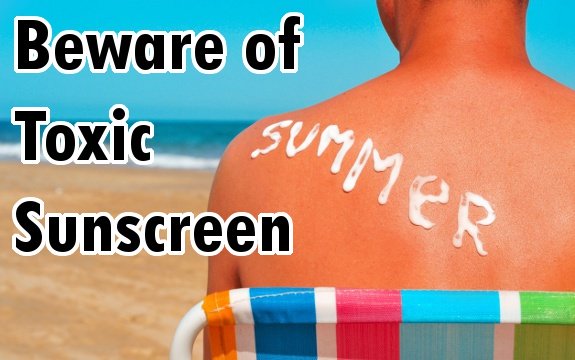The Problem with ‘Regular’ Sunscreens, Plus a List of Safe Sunscreens

 Maybe you slather on SPF 15, or SPF 50. Maybe you just stick with pure coconut oil when you are basking in the sun. What you need to know, though, is that most commercially-made sunscreens are hazardous to your health. Here is why.
Maybe you slather on SPF 15, or SPF 50. Maybe you just stick with pure coconut oil when you are basking in the sun. What you need to know, though, is that most commercially-made sunscreens are hazardous to your health. Here is why.
Sunscreens are meant for use over large portions of the body, and since our skin is one of the largest organs of detox, whatever we put on it ends up inside – either hurting you or harming you. By 1978, when the FDA said it would start looking into what ingredients companies were using to make sunscreen, most of the toxic junk that is harmful was already in use – so no big help there.
There are essentially two ways to filter out the harmful UVA and UVB radiation of the sun – chemical and mineral. Most sunscreen makers have gone the chemical route, but even some mineral sunscreens can be detrimental. Most products contain a combination of these six ingredients: oxybenzone, avobenzone, octisalate, octocrylene, homosalate and octinoxate.
Avobenzone is one of the most commonly used ingredient because it is thought that it blocks UVB radiation the best. The problem with this is that avobenzone is an endocrine disruptor. Laboratory studies of several sunscreen chemicals indicate that they may mimic hormones and disrupt the hormone system. This means that reproductive health is often compromised. Still, other studies have shown that two other ingredients used as stabilizers in sunscreens can even delay development in children.
Read: Sunscreen Causes Cancer?
Oxybenzone; however, is really the troublesome culprit. It is used in over 80% of the sunscreens tested on the US market. The Environmental Working Group and other toxicology experts believe that oxybenzone is linked to hormone disruption and potentially to cell damage that may lead to skin cancer, but the American Academy of Dermatology says oxybenzone is safe, even though the FDA has done no independent studies on its use.
On the natural end, a surprising ‘natural’ ingredient that can be dangerous is retinyl palmitate. This is a form of Vitamin A, and although it only caused increased incidence of skin cancer on lab animals, why would you want to take a chance putting it all over your body?
If this all sounds way too confusing to consider before hitting the beach – you can check out the Environmental Working Group’s guide to safe sunscreen. Zinc oxide-based sunscreens seem to be ranked high on their list, as well as several other mineral based sunscreens.
Enjoy the sun, safely!

Where is the list of safe sunscreens?
The two links in the last paragraph
UVB Rays are NOT harmful: they are the beneficial rays of the sun which give you essential Vitamin D.
Here is a quote from Dr. Mercola:
“While discussions about the health benefits from sun exposure typically center around vitamin D, UVB exposure has a number of other health effects unrelated to vitamin D production, including enhancement of mood and energy, melatonin regulation, suppression of MS symptoms, and the treatment of skin diseases
Exposure to UVB light is also protective against melanoma (the most lethal form of skin cancer), whereas UVA radiation is associated with skin damage.”